NO, ROS, and cell death associated with caspase-like activity increase in stress-induced microspore embryogenesis of barley
- PMID: 22197894
- PMCID: PMC3295391
- DOI: 10.1093/jxb/err400
NO, ROS, and cell death associated with caspase-like activity increase in stress-induced microspore embryogenesis of barley
Abstract
Under specific stress treatments (cold, starvation), in vitro microspores can be induced to deviate from their gametophytic development and switch to embryogenesis, forming haploid embryos and homozygous breeding lines in a short period of time. The inductive stress produces reactive oxygen species (ROS) and nitric oxide (NO), signalling molecules mediating cellular responses, and cell death, modifying the embryogenic microspore response and therefore, the efficiency of the process. This work analysed cell death, caspase 3-like activity, and ROS and NO production (using fluorescence probes and confocal analysis) after inductive stress in barley microspore cultures and embryogenic suspension cultures, as an in vitro system which permitted easy handling for comparison. There was an increase in caspase 3-like activity and cell death after stress treatment in microspore and suspension cultures, while ROS increased in non-induced microspores and suspension cultures. Treatments of the cultures with a caspase 3 inhibitor, DEVD-CHO, significantly reduced the cell death percentages. Stress-treated embryogenic suspension cultures exhibited high NO signals and cell death, while treatment with S-nitrosoglutathione (NO donor) in control suspension cultures resulted in even higher cell death. In contrast, in microspore cultures, NO production was detected after stress, and, in the case of 4-day microspore cultures, in embryogenic microspores accompanying the initiation of cell divisions. Subsequent treatments of stress-treated microspore cultures with ROS and NO scavengers resulted in a decreasing cell death during the early stages, but later they produced a delay in embryo development as well as a decrease in the percentage of embryogenesis in microspores. Results showed that the ROS increase was involved in the stress-induced programmed cell death occurring at early stages in both non-induced microspores and embryogenic suspension cultures; whereas NO played a dual role after stress in the two in vitro systems, one involved in programmed cell death in embryogenic suspension cultures and the other in the initiation of cell division leading to embryogenesis in reprogrammed microspores.
Figures
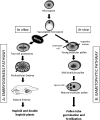



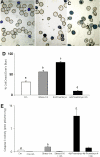





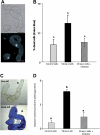
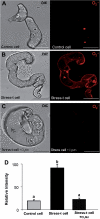
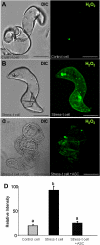
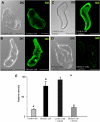

Similar articles
-
Modulation of autophagy and protease activities by small bioactive compounds to reduce cell death and improve stress-induced microspore embryogenesis initiation in rapeseed and barley.Plant Signal Behav. 2019;14(2):1559577. doi: 10.1080/15592324.2018.1559577. Epub 2018 Dec 22. Plant Signal Behav. 2019. PMID: 30582408 Free PMC article.
-
Enhancing microspore embryogenesis initiation by reducing ROS, autophagy, and cell death with novel small molecules in rapeseed and barley.J Plant Physiol. 2025 Aug;311:154546. doi: 10.1016/j.jplph.2025.154546. Epub 2025 Jun 10. J Plant Physiol. 2025. PMID: 40527111
-
Changes in DNA methylation levels and nuclear distribution patterns after microspore reprogramming to embryogenesis in barley.Cytogenet Genome Res. 2014;143(1-3):200-8. doi: 10.1159/000365232. Epub 2014 Jul 26. Cytogenet Genome Res. 2014. PMID: 25074410
-
How microspores transform into haploid embryos: changes associated with embryogenesis induction and microspore-derived embryogenesis.Physiol Plant. 2008 Sep;134(1):1-12. doi: 10.1111/j.1399-3054.2008.01113.x. Epub 2008 Apr 11. Physiol Plant. 2008. PMID: 18507790 Review.
-
Microspore embryogenesis: targeting the determinant factors of stress-induced cell reprogramming for crop improvement.J Exp Bot. 2019 Jun 1;70(11):2965-2978. doi: 10.1093/jxb/ery464. J Exp Bot. 2019. PMID: 30753698 Review.
Cited by
-
Bcl-2△21 and Ac-DEVD-CHO Inhibit Death of Wheat Microspores.Front Plant Sci. 2016 Dec 26;7:1931. doi: 10.3389/fpls.2016.01931. eCollection 2016. Front Plant Sci. 2016. PMID: 28082995 Free PMC article.
-
IMMUNEPOTENT CRP induces cell cycle arrest and caspase-independent regulated cell death in HeLa cells through reactive oxygen species production.BMC Cancer. 2018 Jan 3;18(1):13. doi: 10.1186/s12885-017-3954-5. BMC Cancer. 2018. PMID: 29298674 Free PMC article.
-
Winter wheat cells subjected to freezing temperature undergo death process with features of programmed cell death.Protoplasma. 2014 May;251(3):615-23. doi: 10.1007/s00709-013-0562-3. Epub 2013 Oct 15. Protoplasma. 2014. PMID: 24126671
-
Understanding In Vitro Tissue Culture-Induced Variation Phenomenon in Microspore System.Int J Mol Sci. 2021 Jul 14;22(14):7546. doi: 10.3390/ijms22147546. Int J Mol Sci. 2021. PMID: 34299165 Free PMC article. Review.
-
A Genetically Modified attenuated Listeria Vaccine Expressing HPV16 E7 Kill Tumor Cells in Direct and Antigen-Specific Manner.Front Cell Infect Microbiol. 2017 Jun 29;7:279. doi: 10.3389/fcimb.2017.00279. eCollection 2017. Front Cell Infect Microbiol. 2017. PMID: 28706878 Free PMC article.
References
-
- Apel K, Hirt H. Reactive oxygen species: metabolism, oxidative stress, and signal transduction. Annual Review of Plant Biology. 2004;55:373–399. - PubMed
-
- Arnaud N, Murgia I, Boucherez J, Briat JF, Cellier F, Gaymard F. An iron-induced nitric oxide burst precedes ubiquitin-dependent protein degradation for Arabidopsis AtFer1 ferritin gene expression. Journal of Biological Chemistry. 2006;281:23579–23588. - PubMed
-
- Balestrazzi A, Agoni V, Tava A, Avato P, Biazzi E, Raimondi E, Macovei A, Carbonera D. Cell death induction and nitric oxide biosynthesis in white poplar (Populus alba) suspension cultures exposed to alfalfa saponins. Physiologia Plantarum. 2011;141:227–238. - PubMed
-
- Beligni MV, Lamattina L. Nitric oxide in plants: the history is just beginning. Plant, Cell and Environment. 2001;24:267–278.
Publication types
MeSH terms
Substances
LinkOut - more resources
Full Text Sources
Other Literature Sources
Research Materials

